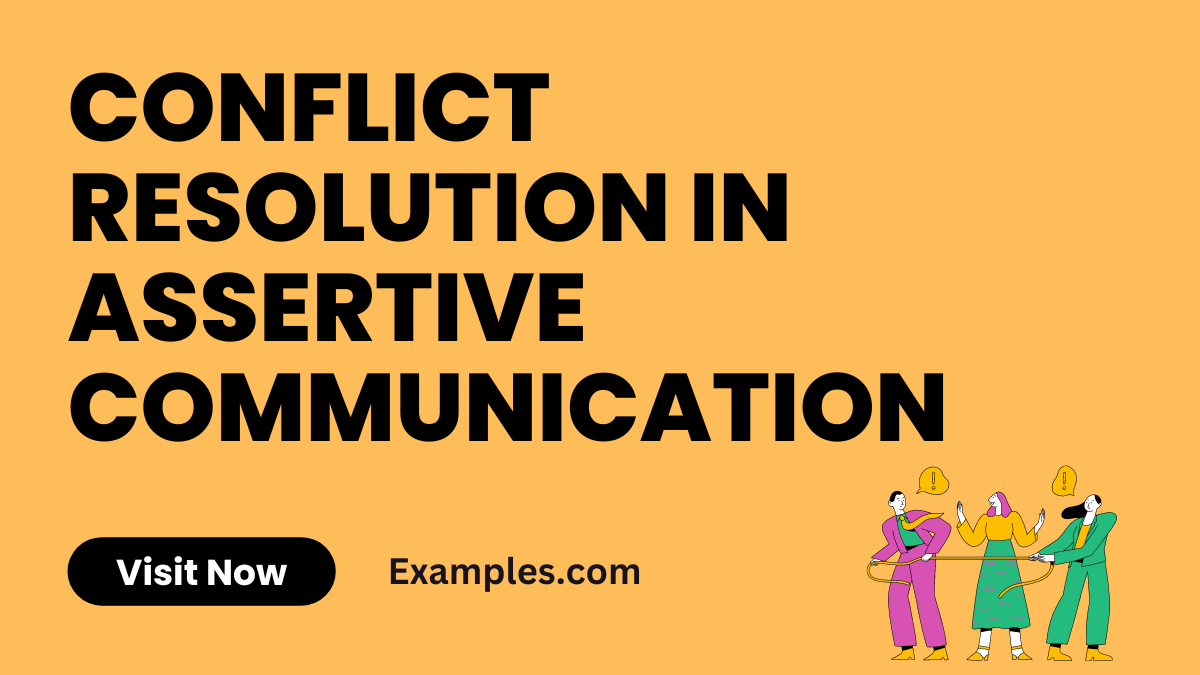Conflict Resolution in Assertive Communication
Unlock the power of Assertive Communication for effective conflict resolution. This comprehensive guide dives into the art of balancing firmness and empathy, providing practical examples and tips. Whether in personal relationships or professional settings, learn how to express your needs and resolve disputes with clarity and confidence, cultivating healthier interactions and understanding.
What is Conflict Resolution in Assertive Communication?
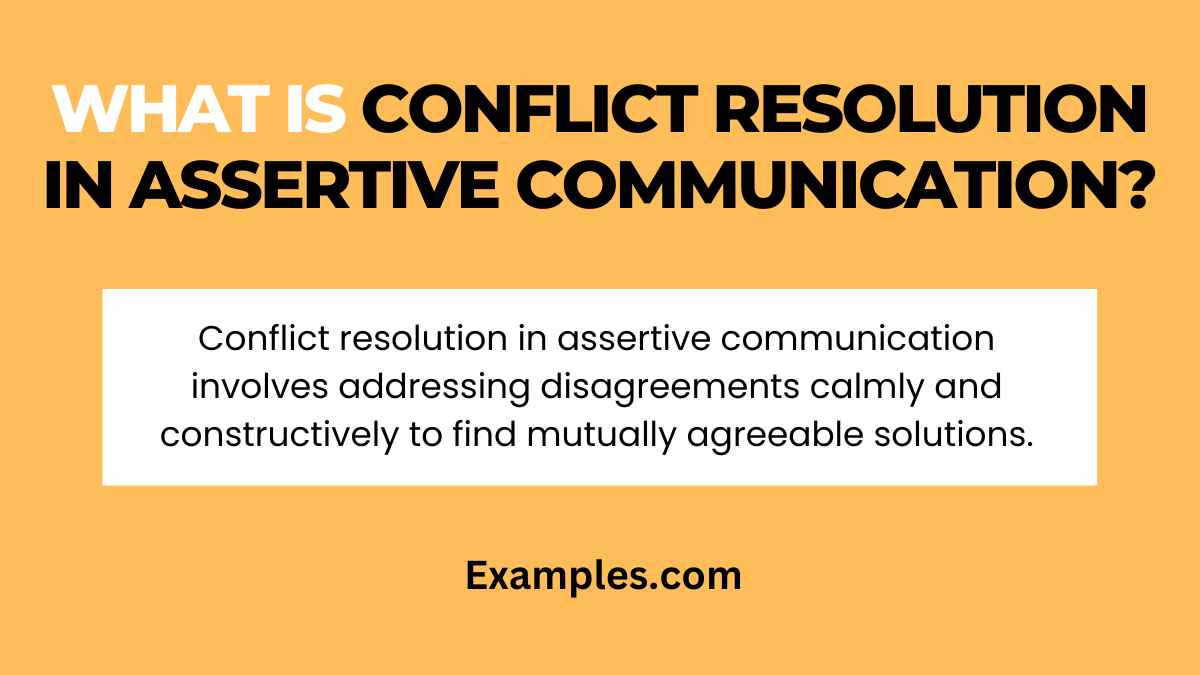
Conflict Resolution in Assertive Communication is the process of addressing disagreements and conflicts through a direct yet respectful approach. It involves expressing one’s own needs, feelings, and opinions clearly and openly, while also listening to and respecting others’ perspectives. This method strives for mutually beneficial outcomes, prioritizing open dialogue and empathy.
What is the Best Example of Conflict Resolution in Assertive Communication?
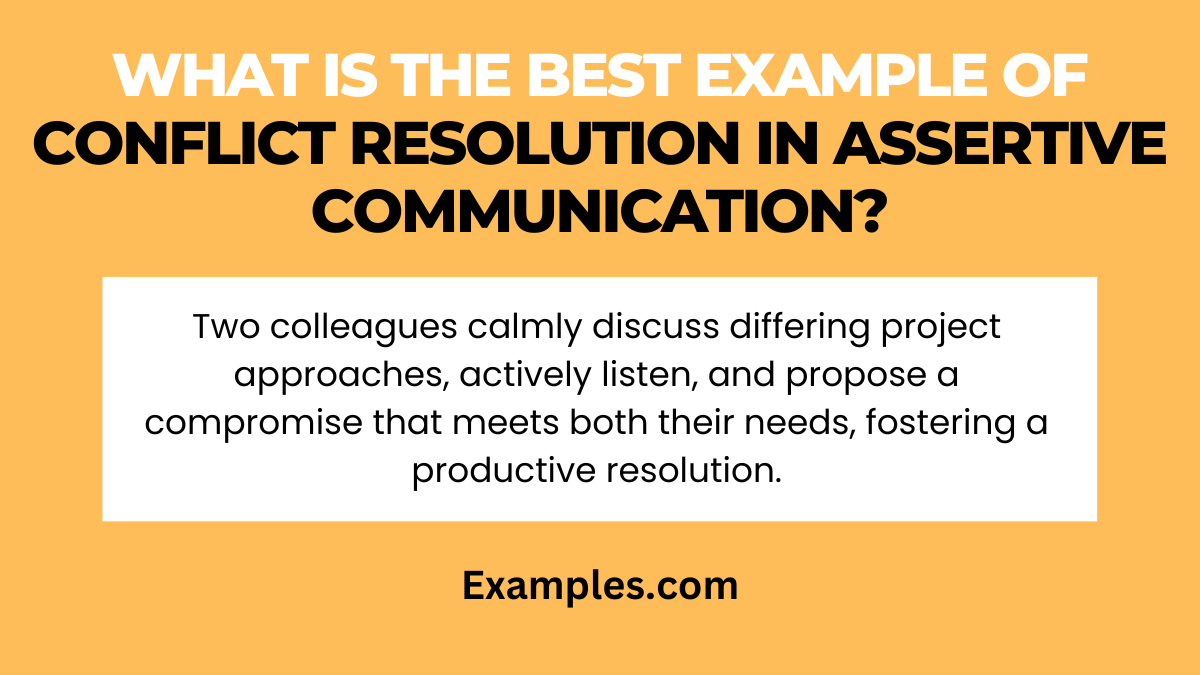
A prime example of Conflict Resolution in Assertive Communication is when a team leader addresses a disagreement between team members. Instead of taking sides, the leader uses Active Listening to understand each person’s viewpoint. They encourage open discussion, ensuring each party feels heard and respected. By using I Statements, the leader expresses their observations without placing blame. This approach helps in finding a solution that acknowledges everyone’s concerns, leading to a constructive and harmonious resolution.
20 Examples of Conflict Resolution in Assertive Communication
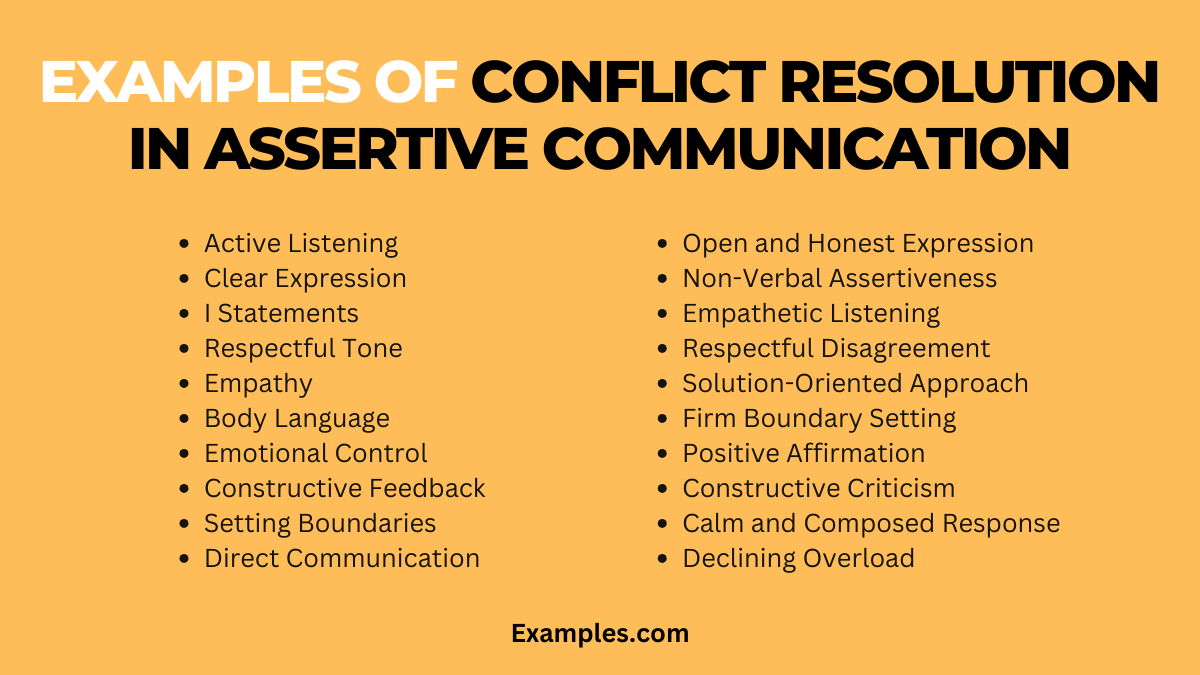
Conflict resolution through Assertive Communication is a vital skill, blending respect, clarity, and confidence. It empowers individuals to express their needs and opinions clearly and respectfully. This guide outlines 20 essential skills for effective conflict resolution using assertive communication, each accompanied by practical examples.
- Active Listening: Focus on understanding the other person’s perspective.
Example: “I hear you saying that you feel overlooked. Can you tell me more about why you feel that way?” - Clear Expression: Be concise and articulate your thoughts clearly.
Example: “I feel frustrated when meetings run overtime as it affects my schedule.” - I Statements: Express feelings without blaming others.
Example: “I feel anxious when deadlines are not met, and I’d like to discuss how we can improve this.” - Respectful Tone: Maintain a calm and respectful tone.
Example: “I respect your viewpoint, but I see things differently. Let’s find a common ground.” - Empathy: Show understanding of the other’s feelings.
Example: “I understand you’re upset, and that’s not my intention. Let’s work this out together.” - Body Language: Use open and non-threatening body language.
Example: Maintain eye contact and nod to show you are engaged in the conversation. - Emotional Control: Keep emotions in check to stay objective.
Example: “I’m feeling a bit heated. Let’s take a brief break and resume in a few minutes.” - Constructive Feedback: Offer feedback that’s helpful, not critical.
Example: “I think your report was good, but adding more data could make it even better.” - Setting Boundaries: Clearly define your limits.
Example: “I’m happy to help, but I need to leave by 5 PM to maintain my work-life balance.” - Direct Communication: Speak directly and honestly.
Example: “I need your input on this project by tomorrow to stay on schedule.” - Open and Honest Expression: Share your thoughts openly but respectfully.
Example: “I honestly don’t agree with this approach. Can we explore other options?” - Non-Verbal Assertiveness: Communicate confidence through your posture and gestures.
Example: Stand straight and make sure your posture reflects your confidence. - Empathetic Listening: Actively listen and respond with understanding.
Example: “It sounds like you’re really passionate about this. Let’s find a way to incorporate your ideas.” - Respectful Disagreement: Disagree without dismissing others.
Example: “I see your point, but here’s another perspective to consider.” - Solution-Oriented Approach: Focus on finding solutions, not dwelling on problems.
Example: “Let’s identify the main issues and brainstorm possible solutions.” - Firm Boundary Setting: Be firm yet polite in setting your limits.
Example: “I can assist with this, but I need to prioritize my current project first.” - Positive Affirmation: Acknowledge and validate others.
Example: “You’ve made a great point, and I appreciate your input.” - Constructive Criticism: Offer critique in a way that’s helpful, not hurtful.
Example: “Your idea is interesting, but it might be more effective if we adjust the approach.” - Calm and Composed Response: Stay calm and composed, even in tense situations.
Example: “I understand this is a heated topic, but let’s try to discuss this calmly.” - Declining Overload: Politely refuse excessive demands.
Example: “While I’d love to help, taking on this task would overload my schedule.”
Importance of Conflict Resolution in Assertive Communication
- Enhances Problem-Solving: Effective conflict resolution within assertive communication ensures problems are addressed constructively, leading to sustainable solutions.
- Builds Respect: By addressing conflicts assertively and respectfully, individuals demonstrate a commitment to maintaining respectful relationships.
- Promotes Understanding: It encourages open dialogue, leading to a deeper understanding of differing perspectives.
- Reduces Stress: Successfully resolving conflicts reduces emotional stress and tension in personal and professional relationships.
- Improves Team Dynamics: In a workplace setting, assertive conflict resolution fosters a more cooperative and collaborative team environment.
- Encourages Personal Growth: It allows individuals to develop skills such as empathy in assertive communication and emotional intelligence.
- Prevents Escalation: Addressing conflicts assertively and early prevents them from escalating into more significant issues.
- Cultivates a Positive Environment: Consistent conflict resolution contributes to a more positive and productive environment, whether at home, work, or in social settings.
Assertive Techniques for Conflict Resolution
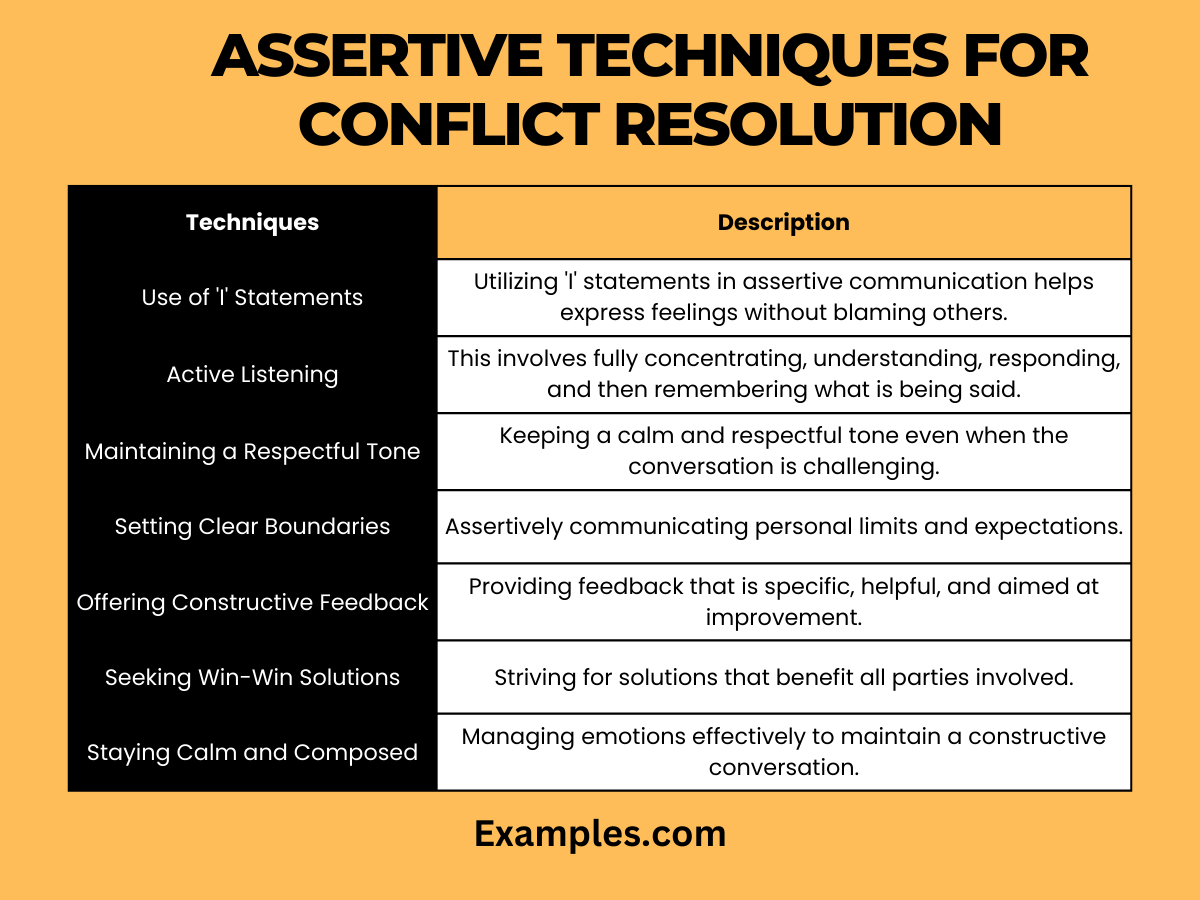
- Use of ‘I’ Statements: Utilizing ‘I’ statements in assertive communication helps express feelings without blaming others.
- Active Listening: This involves fully concentrating, understanding, responding, and then remembering what is being said.
- Maintaining a Respectful Tone: Keeping a calm and respectful tone even when the conversation is challenging.
- Setting Clear Boundaries: Assertively communicating personal limits and expectations.
- Offering Constructive Feedback: Providing feedback that is specific, helpful, and aimed at improvement.
- Seeking Win-Win Solutions: Striving for solutions that benefit all parties involved.
- Staying Calm and Composed: Managing emotions effectively to maintain a constructive conversation.
- Practicing Empathy: Trying to understand the other person’s perspective and feelings.
Role of Conflict Resolution in Assertive Communication
- Facilitates Clear Understanding: It ensures that all parties clearly understand each other’s perspectives and concerns.
- Strengthens Relationships: Resolving conflicts assertively strengthens trust and respect in relationships.
- Promotes Self-Respect: Standing up for oneself in a respectful manner boosts self-esteem and confidence.
- Encourages Open and Honest Communication: Openness leads to more genuine and productive interactions.
- Reduces Misunderstandings: Clear, assertive communication minimizes the chances of misunderstandings.
- Supports Emotional Well-being: It contributes to emotional health by reducing feelings of anger and frustration.
- Improves Decision Making: With better understanding and less conflict, decision-making becomes more effective and inclusive.
- Cultivates a Culture of Respect: Encourages a culture where everyone feels heard and valued.
Mastering conflict resolution through assertive communication is essential for fostering respectful, understanding, and productive interactions. By employing techniques like active listening, respectful tone, and empathy, individuals can navigate conflicts effectively, leading to stronger relationships and enhanced personal growth. Embracing these strategies ensures a healthy, balanced, and assertive approach to handling conflicts in various aspects of life.



